#eliminate yarn waste
Text
Quality Assurance in Yarn Production: SD Polytech's Commitment to Excellence
Introduction
Within the dynamic landscape of textile manufacturing, yarn manufacturers in India play a pivotal role in meeting the global demand for high-quality yarn products. Among these industry leaders, SD Polytech stands out as a beacon of excellence, particularly as Spun Polyester Yarn Producers in India. This blog explores the crucial aspect of quality assurance in yarn production and sheds light on how manufacturers are committed to maintaining the highest standards in the industry.
Quality Assurance: A Cornerstone in Yarn Production
As consumers increasingly demand superior textiles, the significance of quality assurance in yarn production cannot be overstated. Yarn serves as the fundamental building block for various textile products, and its quality directly influences the durability, feel, and appearance of the final goods. The commitment to quality assurance starts from the very beginning of the yarn manufacturing process.
Raw Material Selection: The First Step Towards Excellence
SD Polytech understands that quality yarn begins with quality raw materials. As one of the leading spun polyester yarn producers in India, the company meticulously selects raw materials known for their strength, durability, and consistency. This proactive approach ensures that the yarn produced is of the highest quality, meeting or exceeding industry standards.
State-of-the-Art Manufacturing Processes
Utilizing advanced technology, SD Polytech employs advanced manufacturing processes that prioritize precision and efficiency. From spinning to twisting, every step in the production process undergoes rigorous quality checks to eliminate any deviations from the desired specifications. This meticulous attention to detail sets them apart as one of the foremost yarn manufacturers in India.
Quality Control Measures: Stringent Checks at Every Stage
SD Polytech's commitment to excellence is exemplified by its comprehensive quality control measures implemented at every stage of yarn production. Skilled technicians and modern machinery work in tandem to monitor and regulate parameters such as yarn count, strength, and color consistency. This systematic approach ensures that each batch of yarn meets the stringent quality standards set by both national and international regulatory bodies.

In-House Testing Laboratories: Ensuring Consistency
To guarantee the consistency and reliability of their products, they invest in in-house testing laboratories equipped with advanced testing equipment. This allows the company to conduct a battery of tests, including tensile strength, elongation, and colorfastness, ensuring that the Spun Polyester Yarn produced consistently meets or exceeds customer expectations.
Environmental Responsibility: A Core Value
SD Polytech not only excels in producing high-quality yarn but also upholds a strong commitment to environmental responsibility. The company integrates sustainable practices into its production processes, minimizing waste and reducing the environmental impact associated with yarn manufacturing. This dedication to sustainability aligns with the global shift towards eco-friendly textiles, making them a responsible choice for environmentally conscious consumers.
Customer-Centric Approach: Building Trust Through Quality
At the heart of success is its customer-centric approach. The company recognizes that the textile industry is driven by customer satisfaction, and therefore, it places a premium on building long-term relationships. By consistently delivering high-quality products, they have earned the trust of clients worldwide, solidifying its position as a preferred choice among yarn manufacturers in India.
Conclusion
In conclusion, SD Polytech's commitment to quality assurance in yarn production sets a benchmark in the industry. As one of the leading spun polyester yarn producers in India, the company's dedication to excellence, advanced manufacturing processes, and environmental responsibility position it as a reliable partner for businesses seeking superior yarn products. Choose the best for quality that weaves success into every thread.
Also, Read:
The Comfort Factor: How Cotton Linen Yarns Enhance Wearable Projects
The Role of Bag Closing Threads in Supply Chain Resilience
Originally published by: https://sdpolytech.blogspot.com/
0 notes
Text
YKK’s new dynaPel water-repellant zipper wins best product in ISPO textrends competition
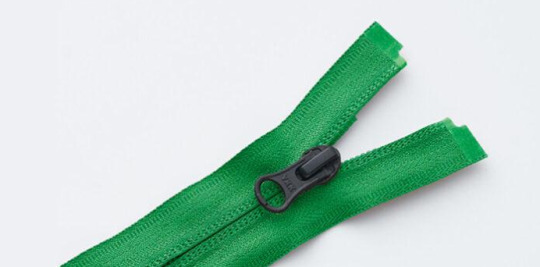
The ISPO Textrends judges have selected YKK's DynaPel water-repellent zipper as the Best Product in the accessories category. The competition, held twice a year in conjunction with the ISPO trade show, recognizes the most innovative performance textiles, components, and apparel.
Designed to be compatible with garment recycling systems, the DynaPel zipper uses GTT’s EMPEL technology instead of the standard PU film to achieve its water-repellency. The lack of a PU film helps remove one of the barriers of textile-to-textile recycling of performance apparel by eliminating the urethane material, which presents challenges to garment recycling processes.[1]
“Receiving an ISPO Textrends Award helps validate the technology and our efforts to develop fasteners for circular systems,” said Terry Tsukumo, Vice President, Product Strategy Division, Global Sales Headquarters, YKK Corporation. “By employing EMPEL technology, we can achieve the robust water protection expected from YKK products while eliminating the challenges that PU poses to recycling systems.”

Conventional chemical and mechanical garment recycling systems cannot process the polyurethane film commonly used on water-repellent zippers, necessitating the removal of zippers from garments before recycling. This additional processing step often deters recyclers from accepting garments with PU zippers, resulting in unnecessary waste.
EMPEL technology uses advanced green chemistry devoid of PFAS and a specialized manufacturing process that allows the chemistry to penetrate the yarn and encapsulate it with a water-repellent layer through molecular cross-linking. The molecular cross-linking creates an extremely durable layer that is highly resistant to abrasion and invisible to the eye.
“DynaPel represents a new generation of sustainable, high-performance water-repellant zippers,” stated Tsukumo. “It is the future of water protection for zippers.”
[1] It is recommended to trial products in your targeted recycling system to fully assess its processability.
0 notes
Text
Hat's Off to Comfort: The Perfect Pairing of Slouch Hats and Dryer Balls

Summary:
In the world of crafting and creativity, yarn stands as a versatile thread that weaves through various aspects of our lives. From cozy outerwear to practical dryer balls, and trendy slouch hat, this blog explores the diverse realms of yarn and its applications. Join us on a journey through the intricate art of yarn crafting, discovering how this humble material transforms into items that bring both warmth and style to our daily lives.
Introduction:
Yarn, a simple yet powerful thread, has been an integral part of human craftsmanship for centuries. Its evolution from basic fibers to a myriad of textures and colors has paved the way for a wide array of creations. In this blog, we delve into the world of yarn, exploring its applications in outerwear, dryer balls, and the trendy slouch hat. Let's unravel the artistry behind each, celebrating the creativity and comfort that yarn brings to our lives.
The Versatility of Yarn in Outerwear:
When it comes to outerwear, yarn takes center stage in crafting garments that are not only functional but also stylish. From chunky knit sweaters to lightweight cardigans, the possibilities are endless. Yarn's natural warmth and breathability make it an ideal choice for crafting outerwear that can seamlessly transition from chilly mornings to cool evenings.
One notable trend is the resurgence of handmade yarn coats and jackets. Crafters are embracing the challenge of creating unique, personalized pieces that stand out in a sea of mass-produced fashion. The tactile nature of yarn allows for intricate patterns and textures, turning outerwear into wearable works of art.

Dryer Balls: A Practical and Eco-Friendly Solution:
In the realm of household items, dryer balls have gained popularity as a sustainable alternative to traditional dryer sheets. These simple spheres, often made from yarn, reduce drying time, soften fabrics, and eliminate the need for disposable products.
Crafting your own dryer balls can be a satisfying and eco-conscious endeavor. By using scrap yarn or repurposing old garments, you not only contribute to waste reduction but also create a practical, reusable solution for your laundry routine. The next time you hear the familiar hum of your dryer, remember that a small ball of yarn is working to make your clothes softer and reduce your environmental footprint.
The Cozy Charm of Slouch Hats:
As we shift our focus from practical household items to trendy accessories, slouch hats emerge as a fashionable and functional use of yarn. The slouch hat, characterized by its loose, relaxed fit, has become a staple in fall and winter wardrobes.
Crafters and fashion enthusiasts alike appreciate the versatility of slouch hats. With various yarn weights and colors available, you can customize a slouch hat to suit any style or outfit. Whether you opt for a classic neutral tone or a bold, eye-catching hue, the slouch hat is a testament to yarn's ability to blend comfort with style.
Conclusion:
In the vast world of crafting, yarn remains a constant source of inspiration and innovation. From the warmth of handmade outerwear to the practicality of dryer balls and the stylish charm of slouch hats, yarn continues to prove its versatility. As we celebrate the artistry behind each creation, let us be reminded of the joy and fulfillment that comes from working with this timeless material. So, whether you're knitting a cozy sweater, crafting eco-friendly dryer balls, or donning a trendy slouch hat, remember that every stitch tells a story, and yarn is the thread that ties it all together.
0 notes
Text
girlfriend collective
Girlfriend collective is a brand that design ethically-made activewear with recycled materials in sizes XXS-6XL.

"WE BELIEVE GOOD THINGS COME TO THOSE WHO DON'T WASTE."
They believe in ethical manufacturing and recycled materials. Because old water bottles and fishing nets look better on you than they do clogging landfills and polluting oceans.
IS EVERYTHING ECO-FRIENDLY?
Being eco-friendly is the companies number one priority, they used certain packaging and materials that will be sustainable and efficient.
Packaging: Their packaging is 100% recycled and recyclable, to prevent landfills.
Clothing: Their clothing is made from recycled materials like post-consumer water bottles, fishing nets retrieved from seas, fabric scraps, and other waste.
HOW DO YOU TURN OLD WATER BOTTLES INTO CLOTHES?
Did you know almost all synthetic activewear is made from plastic? Girlfriend collective make their clothes with the materials that would otherwise clog landfills and pollute the earth. It all starts with post-consumer water bottles that have their labels removed, are crushed into billions of minuscule chips, and then washed until they're clean.
After they are converted through polymerization and you get a soft, recycled yarn that eliminates the need for petroleum and diverts water bottles from landfills at the same time.
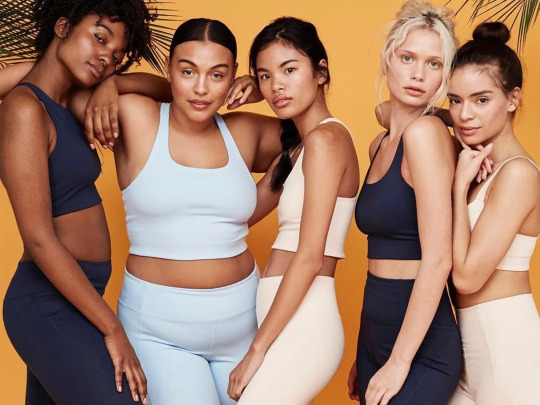
All of their textiles are made from recycled materials in various facilities across the globe. Their primary recycling partners in Taiwan specializes in eco-friendly and high-quality textiles, while their core sewing partner in Vietnam is SA8000 certified, guarantees fair wages, and always ensures safe and healthy conditions.

The company only chooses partners whop believe in the same values as they do- sustainability, ethical manufacturing, and making the very best product you'll love for years to come. Quality is everything to the brand, to give consumers quality products at the best price that you could find.
DYE
The company use eco-friendly dyes to their fabric and the wastewater is carefully cleaned and cooled before it is released. they also donate the dye mud to a local pavement facility where it is recycled into pavements and roads.
POLYESTER
Taiwan, where they source all of our post-consumer water bottles, once struggled to clean up mass amounts of waste resulting from rising living standards and soaring consumption. A small island nation of 23 million people, the government saw the danger of ignoring the problem, and through widespread change has transformed Taiwan into a world leader in recycling, with 55% of waste being recycled- as opposed to 35% in the US.
Recycling is community affair in Taiwan.Each night people gather to sort their waste into containers as a community - recyclables, food waste, and rubbish. Rather than leave, they stay and talk until the truck come and pick it up, turning what could be a tedious affair into a connective one.
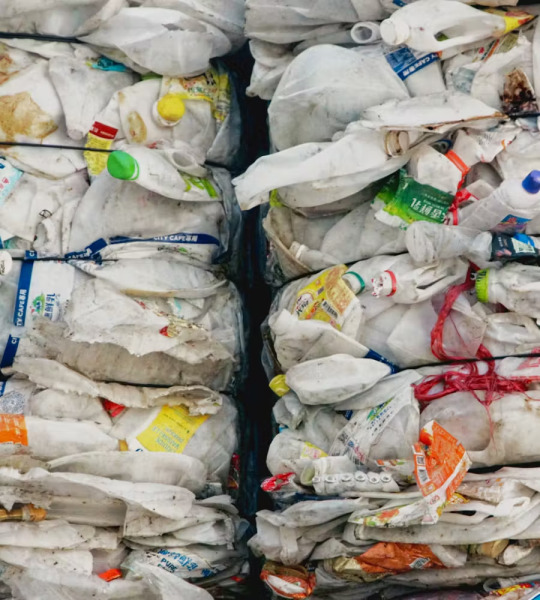
0 notes
Text
From waste to high quality yarn. This is how recycling transforms fabrics into new materials
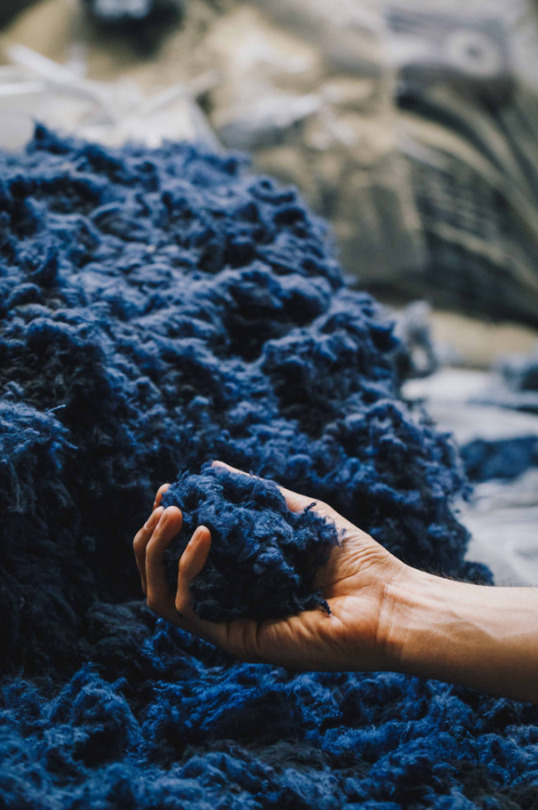
The textile waste that reaches Recover™ is transformed into fluffy recycled cotton that manufacturers will turn into yarn, closing the circle.
Faced with a textile industry that makes 100,000 million garments in the world every year, recycling is proposed as a powerful ally to promote its transformation towards circularity: a tool not without challenges that would enable to reduce the consumption of raw materials and recovering garments. that are discarded.
Bales of fabrics fill the interior of the industrial warehouse: white, pink, red, blue, black... A rainbow of textiles, most of them production waste, which in a matter of time will cease to be waste and become a new material. cousin. Based in the Alicante town of Banyeres de Mariola[1], Recover™[2] knows very well the possibilities offered by textile recycling. They began doing it in the late 1940s out of necessity: faced with a shortage of supplies, the Ferre family, who at that time made bags for their own fertilizers, decided to recycle cotton so they could continue distributing their products. Now, as an independent company, Recover™ continues down that same path out of conviction, manufacturing high-quality recycled cotton fibres to help the industry in its sustainable transformation.
Because textile recycling, as Ana Rodes, senior sustainability manager at Recover™, points out, “plays a very important role in the circular model that is driving the industry. On the one hand, its purpose is to reduce the production of raw materials, such as cotton or polyester, by reusing the materials we already have; on the other hand, it is to reduce the amount of waste we generate in the process.” The figures speak for themselves about this paradox: out of the billion pieces of clothing that are made in the world every year, 92 million tons of clothing end up being thrown away, according to the latest report prepared by the Ellen MacArthur Foundation[3]. “Recycling is accompanied by a change in the consumption model: compared to a linear model, that is based on producing, consuming and throwing away, the idea is to move to a circular model in which the garments last longer and the condition of waste is eliminated.”
In the engineer's words, textile management has been largely forgotten in waste regulations. Firms have been undertaking the task voluntarily for years, [4] bringing used clothing collection services closer to their clients. However, to increase the percentage of textiles that manage to be recovered – the figure, according to data from the latest Moda Re recycling report, is 12.6%[5] – the experts missed a legislative framework such as the one proposed by the European Union, with measures that seek to alleviate its negative effects throughout the value chain, from the design phase, promoting the production of more recyclable garments, until the end of its useful life, a point at which both firms and consumers will share responsibility. In fact, starting in 2025, with the entry into force of the Waste and Contaminated Soil Law[6], clothing will have its own container.
From waste to raw material
The process that recycled fabrics follow is not always the same. At Recover™ they specialize in mechanical recycling, a seemingly simple technology in which textile waste goes through a series of cutting and shredding phases until it becomes a fibre long enough to re-make garments. Simplicity is precisely one of its great advantages: it has a very low environmental impact – according to company data, one kilo of recycled cotton saves 2,216 litres of water, 1.73 kilos of carbon emissions and 15.29 kilowatts of energy – and has enabled the process to be optimized in order to respond to the textile needs of the firms. It even allows you to take advantage of the fabric's own colour and save the dyeing phase.

Mechanical recycling shreds textile waste into small pieces, creating a new fiber that is carefully analyzed to ensure it is of the necessary length for spinning.
All waste that enters the plant is previously classified by composition and colour. The standard they must meet is very strict to ensure that the material will withstand the process and guarantee the quality of the final fibre. Therefore, the majority of its material is post-industrial: all that textile waste that is generated in the production processes and that, in this way, returns to the value chain. At Recover™ they recognize that post-consumer fabrics – clothing deposited in containers – continue to put recycling technology to the test. “This is where the creativity of the brands comes in to make it recyclable: that it has a single material, that it does not have mixtures of colours, that it has the minimum trimmings... If instead of a zipper we can put a cord of the same material of the garment will be much better because nothing has to be removed. When you tear off buttons and zippers, you take with you a small piece of textile that reduces what can be recycled,” Rodes points out. It is all these issues, such as the poor quality of the fabric or the complex composition of the garments, that the European Union wants to address through eco-design.[7] “The technology is very advanced and there are scanners that, when you scan a garment, tell you its composition. The bottleneck of the process is that it needs to be scaled, because there are companies that have it and others that don't,” she concludes.
The mechanical recycling process occurs in several quick stages. The day the video that illustrates this news was recorded struck a blue chord. The operators open the bales of textiles, which go through a first phase of basic cutting and another of extraction, in which zippers and buttons are removed, if there are any. “Quality control is carried out, both manually and by artificial vision, to detect if there is any type of impurity or any material or colour that should not be there,” the employees say. “Next, the antistatic product would be added, the only chemical product in the entire process, which relaxes the fibre and prepares it for the next phase.” It will be quick: in just over 10 minutes, through the different shredding machines, a fluffy cloud of recycled cotton will be created that will be packed and sent to the different spinners, closing the circle. A single raw material with which all types of threads will be made.
Synergy between technologies
Mechanical recycling coexists with chemical recycling. In fact, experts argue that the synergy between both technologies would help solve the limitations of each. Because in the mechanical, the recycling cycles of a fibre are reduced: the length is increasingly shorter and ends up becoming another surplus of production. On the contrary, chemical recycling allows the properties of the most worn fibres to be regenerated.[8] “The product is chemically decomposed until it reaches the monomer level,” Rodes explains. "The material we obtain is no longer cotton, but fibres manufactured by man, but the quality is very similar to that of the virgin product."[9]
CHEMICAL RECYCLING, STEP BY STEP
Although it is still in the development phase, the industry is investigating the formula to optimize chemical recycling and turn it into another ally of circular fashion.

1. Classification - 2. Cutting - 3. Depolymerisation - 4. Elimination - 5. Polymerisation - 6. Optimisation
Source
Noelia Farina, De residuo a hilo de alta calidad. Así transforma el reciclaje los tejidos en nuevos materiales, in:El Päís, 18-10-2023, https://elpais.com/sociedad/moda-futuro-y-accion/2023-10-18/de-residuo-a-hilo-de-alta-calidad-asi-transforma-el-reciclaje-los-tejidos-en-nuevos-materiales.html
[1] Banyeres de Mariola is a settlement and a municipality in the north of the province of Alicante (Spain), 860 metres above sea level, with a population of 7,500. The main employer is the local textile industry.
[2] 75+ years of expertise in sustainable recycled cotton across four generations of family in Spain. Our scaled solution transforms textile waste into high-quality, low-impact fiber. Years of tradition and expertise in the recycling industry provide Recover™ with a unique competitive advantage that no other company on the market can challenge. Our process and technology are unequaled and have a strong environmental benefit: delivering dyed fiber with minimal use of solvents and water, allowing for a truly closed-loop system. The Recover™ recycling process is led by a team of passionate experts in materials science, textiles, fashion and sustainability. We are committed to accelerating the development of a closed-loop industry and guiding our partners on their sustainability path. https://recoverfiber.com/about-us
[3] Each year millions of tonnes of clothes are produced, worn, and thrown away. Every second, the equivalent of a rubbish truck load of clothes is burnt or buried in landfill. The fashion industry is one of the major contributors of plastic microfibres entering our oceans. To solve the problem, we must reinvent fashion itself. https://www.ellenmacarthurfoundation.org/topics/fashion/overview
[4] Read also: https://www.tumblr.com/earaercircular/732357935372615680/the-urban-textile-waste-supply-chain-arrives-at?source=share&ref=_tumblr
[5] https://modare.org/wp-content/uploads/2022/09/PRESS-RELEASE-Sorting-for-Circularity-Europe-Project-and-Report.pdf
[6] Read also: https://www.tumblr.com/earaercircular/690913091543842816/digitisation-of-construction-and-demolition-waste?source=share&ref=_tumblr
[7] Read also: https://www.tumblr.com/earaercircular/722179599996534784/towards-a-circular-and-more-sustainable-fashion?source=share&ref=_tumblr
[8] Read also: https://www.tumblr.com/earaercircular/650429336959303680/nouryon-and-renewcell-build-factory-for-upscaling?source=share&ref=_tumblr
[9] Read also: https://www.tumblr.com/earaercircular/728619189968027648/will-we-ever-be-able-to-recycle-our-clothes-like?source=share&ref=_tumblr
0 notes
Text
Some Of The Best Sustainable Cyclist Clothing Brands

Sustainable Cyclist Clothing Brands
1. Cadenzia
2. Endura
3. Isadore
4. KOSTÜME
5. Maap
6. Matchy Cycling
7. Rapha
8. TIC CC
9. Universal Colours
10. Velocio
1. Cadenzia

Cadenzia launches in spring 2022 and uses a blend of bamboo viscose and recycled polyester in its cycling jersey.
“Bamboo is woven with recycled polyester to create a super soft, high-performance ripstop fabric that is durable and long-lasting,” explains co-founder Rob Stross.
“Bamboo is a sustainable fiber, has natural performance benefits and is also one of the fastest growing plants on earth and one of the most sustainable and renewable resources on earth. world."
“All of our polyester and nylon fabrics are recycled and Oeko-Tex certified, and we only use YKK Natulon recycled ocean plastic zippers.”
The brand will have a line of cycling essentials, with three out-of-season and gender-neutral colors in its range, aiming to eliminate waste.
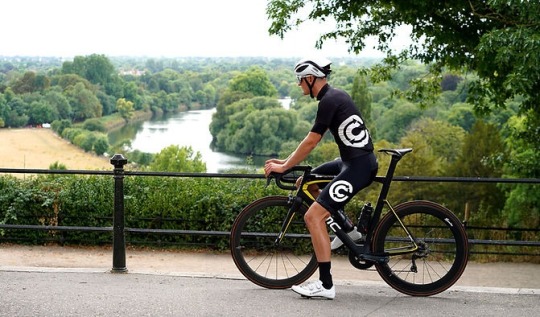
“Our jersey fabric is made in one color, natural unbleached white and the other colors are then computer printed with eco-friendly dyes directly onto the pattern pieces,” Stross adds. ”.
Currently, products verified to contain at least 20% recycled materials can be classified as recycled, and all of its waterproof products are free of PFCs (perfluorinated chemicals used to make fabric is waterproof and very harmful to the environment).
Cadenzia products are manufactured in China and shipped to the UK. When the company established its supply chain in Shanghai, it ensured that it was fully localized to the local area so it could track and reduce its carbon footprint,
2. Endura
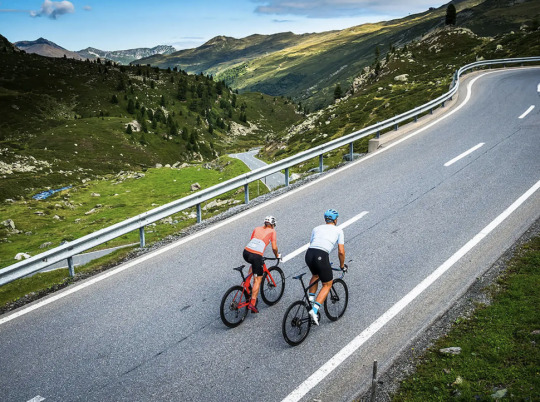
Endura kit is built to last and be durable, which is why Scottish brand Endura, famous for its durable cycle clothing, was born.
Endura incorporates recycled fabrics into its product line in an effort to eliminate waste.
“They chose to use recycled fibers on polyester rather than nylon because they have more impact on polyester and solve the problem of plastic bottle waste,” explains Pamela Barclay, product manager at Endura.
“This reflects why we don't have more styles with recycled fibers.”

According to the brand, 100% of mountain bike jerseys use recycled fabric compared to 33% of road jerseys. However, the brand hopes to increase this final figure to 100% from 2023.
The brand also only markets a product as recycled if it uses more than 50% recycled fibers.
In 2020, Endura launched the One Million Trees initiative, in which they pledged to plant one million trees every year for the next 10 years to offset their carbon emissions and aim to become carbon negative by the year 2024.
Planting began in Mozambique and has now also begun in Scotland, the brand's country of origin. All Endura products have been PFC-free since 2018, and the company makes all its personalized clothing at its factory in Scotland and the rest in China and Asia.
3. Isadore

The brainchild of ex-pros and brothers Martin and Peter Velits, Isadore releases a sustainability report every year, with details of where its products are produced, progress it has made, as well as new aims and initiatives.
The brand is working on core garment traceability and aims to replace all virgin synthetic materials in its products with their recycled counterparts by 2025.
Much of Isadore’s kit is made from recycled materials and the brand recently introduced a majority recycled indoor line.
‘The most important part is that there is no performance difference between using virgin synthetics or recycled fabrics,’ explains Martin. ‘Our Alternative line is made entirely from recycled fabrics and we hope to eventually use 90% recycled sources for the synthetic materials.’

Isadore also uses a lot of merino wool in its products. The wool comes from New Zealand and Australia and then gets processed in Germany where the yarns are produced. The fabric is then woven or laminated in the Czech Republic.
Isadore only works with Oeko-Tex and Bluesign certified suppliers and manufacturers.
Isadore currently doesn’t have the resources to measure and communicate its carbon emissions but is working with its shipping partners to switch to carbon neutral or zero emissions programmes.
The brand plans to have an independent audit to go through all its processes in the future.
4. KOSTÜME

KOSTÜME is a very small new brand which has a different business model to others in this guide. Founded by Ed Bartlett, KOSTÜME caps each of its collections to a small number and pre-sells them in advance which it says significantly reduces waste.
‘The fact is that the fashion industry – and that includes cycling apparel – is locked into a business model that creates unfathomable amounts of waste, right throughout the production and retail process,’ explains Bartlett.
‘We are nowhere near a point where so-called sustainable fabrics are going to fix our ecological problems, so the only way to really make an impact is to stop the waste at source, which is where our model comes in.
‘We also do other things like sharing fabric offcuts across multiple products, no hang tags in our packaging, 100% compostable packaging, working with factories with a clear focus on sustainability – but really it’s the limited pre-order model that makes the difference.’
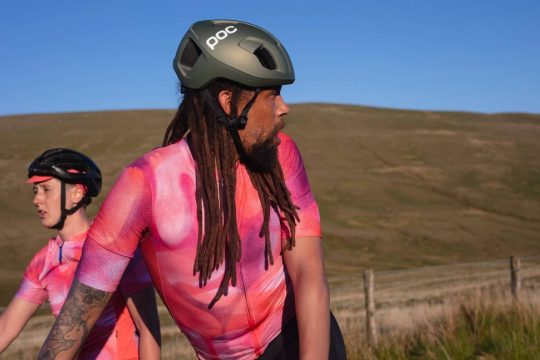
100% of the current range is made from certified recycled materials, and also feature either bluesign, OEKO-TEX or GRS certification.
The brand’s main factory is 70% powered by renewable energy, and KOSTÜME donates a percentage of every sale to Stripe Climate, an organisation which is specifically focused on investing in carbon capture and removal solutions.
KOSTÜME does not yet track its overall carbon footprint but it has plans to do this in the future, alongside a product repair and takeback scheme.
5. Maap

Australian brand Maap was the first cycling brand to join Bluesign as a full partner.
‘If something is a Bluesign partner, you know that audits have been done and that there will be a certain level of sustainability, which automatically gives you that peace of mind,’ explains Darren Tabone, VP of product at Maap.
‘In our case, Bluesign act like a bit of a big brother, they evaluate your organisation, help review your supply chain and look at all different tiers of the code. Becoming more sustainable is a journey and there’s no real end goal in the sense that you are constantly evolving and learning.’
The brand current uses 95% Bluesign or Oeko-Tex materials and aims to up this to 100% by the end of 2022.
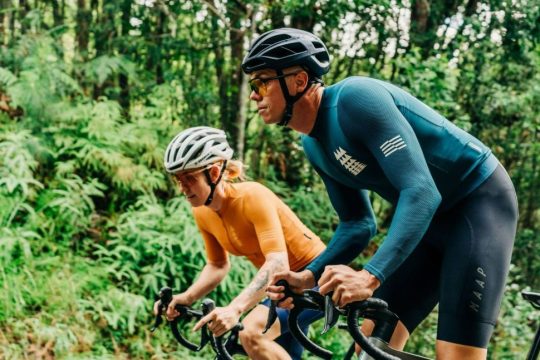
The majority of Maap’s printed fabrics use Green Soul technology which combines sustainable recycled fibres with the environmentally friendly dyeing and finishing processes. It also has had an OffCuts program since 2021 where it makes cycling jerseys out of excess fabric from previous production runs.
The bulk of Maap products are made in Europe and it is expanding its Asia source base.
The brand is not tracking the carbon emissions yet but this is part of its future plan. It is currently in the process of working out the tonnage of products which are from Bluesign-approved raw materials.
6. Matchy Cycling

Founded in 2016, Matchy Cycling is a French brand based in Annecy. All of its products are made from 30% to 100% recycled materials and the brand is extremely conscious of ensuring local production.
‘We prefer a product made in France using a French fabric that is not recycled than a recycled fabrics made super-far away,’ says Geoffrey Baudoin co-founder of Matchy.
‘All of our bib shorts are made in Italy because the chamois come from Italy so it avoids unnecessary shipping.
‘Some fabrics made by a supplier in France are three times more expensive than usual fabrics but offer a much better durability. It’s a complex topic and we need to look outside of just recycled fabrics even if it’s still an important point for us.
‘All recycled fabrics are not equal, it depends on the supplier and where they come from. The trend has obliged suppliers to invest in these fabrics and we can now say that recycled fibres are almost equal as virgin fibres.’

This year, Matchy begun tracking its footprint and is working with third parties to help understand it. The brand also hopes to become a B Corp by the end of this year.
‘Offering recycled products is one thing but we really try to go deeper as globally we need to reduce our impact which means extending the life cycle of the products, by repairing them, or giving them a second life,’ adds Baudoin. ‘We are working with a local tailor to offer upcycled products this winter.’
All of Matchy’s products are Bluesign-approved and use OekeTex material. The brand does not use any plastic packaging, only recyclable and compostable materials.
7. Rapha

Rapha currently produces 90% virgin materials and 10% environmentally preferred materials (recycled, certified organic or animal welfare versions) by volume but has pledged to flip this on its head by 2025.
‘Some people might be not impressed with 10% today, but it’s all about what we’re trying to get to,’ explains Duncan Money, Rapha’s head of social and environmental impact. ‘It is a journey, and we will be doubling that figure nearly every year to get there.’
Like Endura, Rapha doesn’t publicly market a product as environmentally preferred until this accounts for more than 50% of the product by weight.

Rapha aims to become carbon neutral by 2025, across scope 1, 2 and 3 emissions.
- Scope 1 emissions refer to direct GHG emissions that occur from sources that are controlled or owned by an organisation, such as emissions from company vehicles
- Scope 2 emissions refer to indirect GHG emissions associated with the purchase of electricity, steam, heat, or cooling, and are a result of an organisation’s energy usage
- There are also Scope 3 emissions, which include all other indirect emissions that occur in a company’s value chain
It is currently working on its Science-Based Targets and will release these in the middle of the year.
Rapha is also one of the founding signatories of the Shift Cycling Culture Climate Commitment.
‘Even if you just looked at it by weight, it’s quite obvious which one we should be addressing first and which one people should be challenging us on,’ says Money.
‘The cycling industry has the potential to be an incredible force for good in the world, but to make the necessary changes we need to take action with urgency, together.’
Rapha is a member of the Sustainable Apparel Coalition and uses Bluesign and Oeko-Tex certified materials
8. TIC CC

In 2019, TIC CC undertook a year-long period of ‘environmental reflection’ which led to 95% of the brand’s SS21 collection being made with recycled fabrics.
The brand also reworked its supply chains so that 98% of fabrics and components now come from Europe.
For TIC CC co-founder Andrew Monk, taking a holistic approach is an important factor to an evolving sustainability journey.
‘We find that a combination of recycled and virgin fabrics works best,’ says Monk.
‘Of course, this will change as technology improves but you have to take a holistic approach, looking at other impacts including production methodology and distance travelled from source.’

Notably, TIC CC advocates using a Guppyfriend washing bag when washing cycling clothing.
Washing cycling kit in this bag prevents microplastic pollution from synthetic micro fibres getting into waterways.
TIC CC and all of its key manufacturing partners use 100% renewable energy and the brand uses Bluesign and Oeko-Tex certified materials.
TIC CC kit is made in Europe, and its caps are handmade in the UK.
The brand has been tracking its emissions internally for the past three years and is considering getting this data accredited in the futu
9. Universal Colours

London-based Universal Colours takes an innovative conscious approach to its products.
The brand uses pre-consumer waste and post-consumer waste fabrics and a fluorocarbon-free durable water repellent (DWR), called C0 which is a sustainable, vegetable-based technology.
The brand aims to produce considerately sourced cycling clothing but to also educate the consumer on how to care for its garments in order to maximise their longevity.
‘With all our waterproof jackets we give a sample of Nickwax aftercare to reproof it,’ says Will Hurd, a designer at Universal Colours. ‘It’s really important that we communicate to our customers the importance of looking after a product. It’s wrong to assume that customers know what reproofing is.’
But it isn’t straightforward as Hurd explains: ‘We have our own paradox and our own complications because we know our price points are not accessible for everyone. But I think we are very clear and transparent about our fabrics, our costs and have strong ethical policies that we stand by.’

The brand also champions a circular approach, notably in its 100% taste-free biodegradable polyethylene bottle constructed using sugarcane, which can be wholly recycled.
At the correct temperature in a landfill or under leaves and soil in a forest, the bio-batch additive activates, and the bottle decomposes into water, humus and gas.
The brand says the composting process takes 1-5 years, compared to 450 years for a traditional plastic bottle, and the bottle becomes part of the natural world again.
Most of its products are produced at LTP in Lithuania which is a Bluesign-accredited factory, and the brand also works with a factories in China and Taiwan for select products.
Universal Colours is currently looking into tracking its emissions and is also a member of 1% for the planet
10. Velocio

The majority of Velocio’s products incorporate recycled or natural fibre, including all of its Spring/Summer jersey line. The brand is aiming to expand the use of these materials into the rest of its collection.
Velocio makes its kit in facilities which use renewable energy, primarily solar and produces clothing in small-batch quantities in order to conserve energy, limit overstock and reduce liquidation.
‘It’s ironic given that the bicycle can be such an environmentally friendly mode of transportation, but the industry at large, especially at the aspirational end, has pushed newer/better/faster as their primary marketing language for so long that bikes are essentially disposable,’ says Brad Sheehan, CEO and co-founder of Velocio.

‘That mentality has been absorbed by consumers and it’s the main thing we hope to push back on.’
‘It’s also not enough to just use recycled fabrics. We’re also looking at the manufacturing partners, fabric suppliers, and end of life phases of our apparel to see how we can improve the entire life cycle.’
Velocio uses Bluesign and Oeko-Tex certified suppliers and is also a member of 1% for the planet.
Interested in sustainability and cycling? Check out
Read the full article
0 notes
Text
Circular Economy Solutions: Your Path to Achieving a Zero Carbon Footprint
A circular economy is a departure from the traditional linear economic model. Instead of constantly producing new items from raw materials, using them, and then disposing of them, businesses aim to extend the lifespan of resources and products as much as possible. This shift aligns closely with the principles advocated by Pashupati's vision, which emphasizes a revolutionary shift towards a product-focused strategy.
Within our own processing facilities, we engage in the collection, segregation, and chemical recycling of post-consumer and post-industrial PET waste. This has enabled us to establish India's highest processing capacity for PET bottle recycling. Our PET bottle washing line is the longest and most productive in the country, processing 6.5 tons per hour. Even consumer waste is repurposed into materials like PP, PE, LLD PE, and PVC. As we vigorously pursue reuse and recycling, we are committed to achieving a zero carbon footprint in the coming decade.
By 2024, our vision is to eliminate waste generation entirely. Having already accomplished Zero Liquid Discharge in 2022, we are set to implement a comprehensive Carbon Offset Plan. Moreover, our future plans at Pashupati include the efficient conversion of waste into energy. With the integration of energy recovery technologies, renewable energy sources are projected to account for up to 30% of our energy usage by 2025.
Addressing water conservation is another pivotal aspect of our carbon footprint reduction efforts. The production and treatment of water consume significant amounts of energy. Therefore, conserving water usage can lead to substantial reductions in greenhouse gas emissions. We have set an audacious target to increase our water recycling rate to an unprecedented 90% by 2025. Our initiatives span from rainwater harvesting to raising consumer awareness, and we stand ready to support you in minimizing your environmental impact.
From manufacturing bottles to producing fibers, yarns, woven fabric, geotextiles, and even clothing and packaging materials, we are dedicated to incorporating sustainable inputs into your production cycle. This ensures the extraction of maximum value from these resources and promotes their integration into a circular economy. With this shared objective for the betterment of our planet, we eagerly anticipate collaborations with likeminded companies such as yours, as we work towards creating a larger, stronger, and undoubtedly sustainable collective impact on a global scale.
#pashupati group of industries#plastic recyling#recycling#pashupati group#sustainability#reduce reuse recycle
0 notes
Text
Types of Fabric for Shoes

The choice of fabric plays a significant role in the quality and functionality of footwear. Recognising this, Coats provides highly engineered fabric for shoes, along with compatible sewing threads. After the acquisition of Rhenoflex and Texon, Coats now boasts a comprehensive range of components catering to the footwear industry. Let’s explore some of the specialised fabrics they offer for shoes.
Rhenoprint
A part of the Rhenoflex line, Rhenoprint is a cutting-edge reinforcement fabric for shoes. It is noteworthy for its 100% waste-free production, which not only minimises environmental impact but also allows for high customisation. Depending on customer needs, Rhenoprint can be tailored to specific hardness levels, shapes, and thicknesses while reducing the need for additional trimming or die-cutting.
ProWeave
ProWeave is a high-performance jacquard fabric for shoes designed with technical apparel in mind. It melds functional weaving with creative design and advanced technology, resulting in a highly durable and versatile fabric. One standout feature is ProWeave’s multi-directional zonal stretch, which allows for seamless and unique designs. The fabric comes in an array of yarn weights, thicknesses, and colours, offering a broad scope for innovation in luxury, industrial, and performance footwear.
Vogue
If you're looking for fabric for shoes that combines aesthetics with durability, Vogue is an excellent pick. Created primarily from cellulose material, it is washable, sustainable, and versatile. A robust alternative to leather, Vogue comes in various finishes, colours, and thicknesses. Its adaptability extends to coatings, laminations, and printing, allowing designers greater creative freedom.
Lattice and Lattice Lite
Developed to complement Synergex composite fibres, Lattice and Lattice Lite technologies focus on waste elimination and performance maximisation. Lattice employs a continuous fibre-laying technique that speeds up preform manufacturing without the need to cut fibres. This enables precise control over fibre direction and positioning. Lattice Lite, on the other hand, delivers moulded composite products tailored to customer specifications, ideal for applications like footwear plates and bindings.
Lattice Lite Eco
In line with growing eco-consciousness, Coats offers Lattice Lite Eco, a pioneering fabric for shoes that centres on sustainability. This technology enables the precise placement of fibres like PA11, recycled PA6, and basalt fibre to create high-performance, eco-friendly toe caps and footwear.
Choosing the perfect fabric for your footwear needs
If you're in the business of footwear manufacturing, Coats offers a variety of solutions tailored to your needs. Reach out to their experts to find out which fabric for shoes best suits your application. They also provide value-added services and tools to assist in selecting the perfect threads and fabrics for your specific needs.
About the author:
Coats offer different types of thread, and learning which one works best for different sewing tasks is crucial. Brush up your wardrobe with Coats thread, which is the most fashionable, durable, and affordable thread on the market. They provide some of the best sewing threads in the world, including premium polyester and fibre optic yarns. Many leading brands use Coats threads. Moreover, Coats is an expert in designing and supplying a diverse range of technical products to the Performance Materials sector, which serves various strategic end-use markets.
0 notes
Text
Dovetail Workwear teams with CiCLO to create environmentally friendly apparel
There are a few things that are certain in Pensacola that you will have to deal with at some point - tree removal and tree trimming. Before you hire a Tree Removal in Pensacola company you should take into consideration before hiring a tree service company.
Some of the things you should consider include:
- The type of tree that needs to be removed
- The size of the tree
- The location of the tree
- The condition of the tree
If you are unsure about whether or not you need to hire a tree removal company, contact Tree removal company in Pensacola for a consultation. We will be able to assess your situation and give you our professional opinion.
Dovetail Workwear partnered with CiCLO technology to reduce the environmental impact of textile production and launch its new shop pant designed for women. The new shop pant integrates CiCLO nylon fibers woven into cotton to create a durable and long-lasting garment with materials that will reabsorb back into the environment post-consumer use.
“Providing a true dirt-to-dirt experience, the inaugural run of our durable shop pant is a testament to our efforts to push the boundaries for women’s workwear — from the first step of product development to the final days after the life cycle of the garment,” said Sara DeLuca, Dovetail co-founder and director of product development. “The CiCLO fibers and cotton construction break down like natural materials do in environments where microfibers are prolific pollutants — including sea, water, and soil — and minimize accumulation in landfills.”
Shop Pant offers a higher waist design with ten pockets and a panel-free leg face for women who prefer a pant without reinforced front panels. The durability and added strength of CiCLO-infused nylon in the warp yarns eliminate the need for panels and rivets, according to the company.
“We are leading innovative efforts to reduce the environmental impact of synthetic microfiber pollution in landfill, sea water, wastewater treatment plants and soil,” said Andrea Ferris, co-Founder and co-inventor of CiCLO technology. “When synthetic textiles unavoidably leak into the environment during manufacture, use and care; CiCLO fibers, unlike other non-CiCLO synthetics, behave more like natural fibers, such as wool. As a result, we leave less waste behind on our journey to create the best products and a more healthy, happy planet.”
Dovetail will offer the shop pant ($109) in vintage stripe and olive green, with two inseam length options and sizes ranging from 000-18. The shop pant is now available for purchase at Dovetail.com.
The post Dovetail Workwear teams with CiCLO to create environmentally friendly apparel first appeared on Landscape Management.
0 notes
Text
Dryer Balls: An Eco-Friendly and Efficient Laundry Solution
Laundry day can sometimes feel like a chore, but innovative solutions like dryer balls are changing the game. These small, woolen wonders offer an eco-friendly and efficient alternative to traditional dryer sheets. By incorporating them into your laundry routine, you're not only making a positive impact on the environment but also enjoying quicker drying times and softer fabrics.

What Are Dryer Balls?
Dryer balls are exactly what they sound like: balls made from natural materials, most commonly wool, designed to be used in your dryer. They work by helping to separate clothes during the drying cycle, preventing items from clumping together. This separation allows warm air to circulate more effectively, leading to faster drying times.
The Benefits of Using Dryer Balls
Using dryer balls comes with several benefits. Firstly, they can significantly reduce drying time, which translates to lower energy consumption and reduced utility bills. Additionally, dryer balls help to soften fabrics naturally, eliminating the need for chemical-laden fabric softeners. This is particularly beneficial for those with sensitive skin or allergies.
How Do Dryer Balls Work?
The mechanics behind wool dryer balls are quite simple yet effective. As they tumble around in the dryer, they create space between clothes, allowing air to flow and moisture to evaporate more efficiently. This not only speeds up drying but also helps to prevent wrinkles. Some dryer balls are infused with essential oils, adding a pleasant scent to your laundry without resorting to synthetic fragrances.
Wool Dryer Balls vs. Traditional Dryer Sheets
One common comparison is between wool dryer balls and traditional dryer sheets. While dryer sheets are convenient, they often contain chemicals that can irritate the skin and harm the environment. Wool dryer balls, on the other hand, are a natural and reusable alternative. They are hypoallergenic, free from synthetic fragrances, and can be used for numerous drying cycles.
Using Essential Oils with Dryer Balls
If you're missing the fresh scent that traditional dryer sheets provide, consider using essential oils with your dryer balls. Simply add a few drops of your favorite essential oil to the dryer balls before each cycle. This imparts a pleasant aroma to your laundry while avoiding the potential health risks associated with synthetic fragrances.
Are Dryer Balls Safe for All Fabrics?
Yes, dryer balls are generally safe for all fabrics. Their gentle yet effective action ensures that delicate fabrics won't be damaged during the drying process. However, it's always a good idea to test a small area before using them with a new type of fabric.
Tips for Using Dryer Balls Effectively
Use at least three dryer balls per load for optimal results.
Consider using more balls for larger loads.
Keep an eye on drying times and adjust as needed.
The Environmental Impact of Dryer Balls
Dryer balls offer a more sustainable approach to laundry. By reducing drying time, they help conserve energy and lower your carbon footprint. Furthermore, since they are reusable and biodegradable, they generate less waste compared to disposable dryer sheets.
Making Your Own Dryer Balls: A DIY Guide
If you're feeling crafty, making your own dryer balls can be a rewarding project. All you need is some wool yarn, a pair of pantyhose, and a bit of time. By crafting your own dryer balls, you can personalize them with different colors and scents, all while contributing to a greener planet.
Conclusion
Incorporating wool dryer balls into your laundry routine can bring about a positive change. These simple yet effective tools offer a host of benefits, from reducing drying time and energy consumption to providing softer and fresher-smelling fabrics. By choosing a more sustainable option, you're taking a step toward a greener and more efficient way of doing laundry.
0 notes
Text
Industrial Dryers Strengthening Economy and additionally Return
Opening
For warehousing locations, valuable and additionally good drying systems carry out a necessary place in a variety of output process. Warehousing dryers really are prestigious makers manufactured to take off fluids or possibly other sorts of unpredictable contents right from a lot of equipment, for example nasty chemicals, textiles, foods, drugs, and better. Using complex technological innovations and additionally optimizing drying parameters, all of these amazing platforms allow for business owners to perform more significant return, greater superior quality manipulate, and additionally cheaper energy levels content. This explores the important qualities, job applications, and additionally potential benefits to warehousing dryers in the present warehousing surfaces.
máy sấy thực phẩm công nghiệp
Varieties Warehousing Dryers
Warehousing dryers come into play various kinds, any individualized to make sure you targeted job applications and additionally equipment. A lot of usual models feature:
Rotary Dryers: However these are accommodating and additionally popular dryers usually composed of a fabulous twisting drum which usually offers all the drying technique with guide or possibly indirect temperatures convert.
Fluidized Understructure Dryers: Individuals use a high-velocity stream online about discuss or possibly the cost of gas to make sure you hang and additionally carry around contaminants, making sure of valuable drying at the same time minimizing unit degradation.
Squirt Dryers: All of these dryers atomize a fabulous solution satisfy right into ok droplets, which you'll find extremely fast dry simply because they touch a fabulous awesome the cost of gas stream online.
Conveyor Dryers: Acceptable for frequent drying, all of these platforms use a moving about belt or possibly sequence to move equipment through a orthopedic appropriate slot, making sure of gi drying.
Void Dryers: Individuals deliver the results located at cheaper anxiety, permitting low-temperature drying and therefore the availability about heat-sensitive equipment.
Job applications about Warehousing Dryers
Warehousing dryers look for job applications upon a lot of areas, for example:
Not organic Enterprise: Warehousing dryers carry out a crucial place for drying nasty chemicals, that include fertilizers, colors, chemical dyes, and additionally prescription intermediates, making sure of long-standing and additionally gi supplements.
Cuisine Making: Dryers are engaged in order to fluids right from many different foods, that include grains, vegetables, home grown vegetables, and additionally the meat selections, boosting most of the shelf lifespan at the same time preserving superior quality and additionally zest.
Sheet Enterprise: Warehousing dryers are accustomed to make sure you not damp textiles, for example staple fibers, yarns, products, and additionally clothing, facilitating quickly formulation cycles and additionally upgraded cloth fabric superior quality.
Drugs: On the prescription enterprise, drying is obviously important for those formulation about medication, permitting specific dosing, harmony, and additionally huge shelf lifespan.
Energy levels and additionally Natural world: Dryers are widely-used on the formulation about biofuels, combined with for waste matter software process to relief fluids content and articles for all natural waste matter, facilitating valuable fingertips or possibly renovation.
Potential benefits to Warehousing Dryers
Heightened Economy: Warehousing dryers are designed to boost all the drying technique, making sure of quickly and better valuable surgical treatments. Individuals eliminate drying conditions, complement return, and permit just for more significant throughput.
Greater Unit Superior quality: Regulated drying parameters and additionally complex technological innovations benefit keep up with the consistency and additionally superior quality for the dry equipment. This is exactly really important for areas just where real fluids content and articles is obviously important just for unit general performance and additionally harmony.
Energy levels Economy: Cutting-edge warehousing dryers really are built to minimize energy levels content, choosing complex temperatures convert ways and additionally technique control buttons. It will help to eliminate working with price ranges and additionally external have an effect on.
Technique Suppleness: Warehousing dryers is made to order to adjust to targeted drying standards, permitting suppleness in the case of fluids fading, high temperature, and additionally circulation manipulate.
Upgraded Essential safety: Warehousing dryers are equipped with essential safety qualities, that include high temperature devices, circulation inspecting, and additionally instant shutdown platforms. This approach provides healthy and additionally good company at the same time minimizing also about collisions.
Result
Warehousing dryers really are vital software in several output process, featuring valuable fluids fading and additionally strengthening unit superior quality upon many different areas. By their power to boost drying parameters, eliminate energy levels content, and additionally better technique economy, all of these makers add up to heightened return and additionally productivity. Like solutions is constantly on the advancement, warehousing dryers really are ready to start to be further valuable and additionally accommodating, get together all the changing really needs about cutting-edge warehousing surgical treatments.
0 notes
Text
Streamlining Production: The Benefits of Automatic Reeling Machines
In today’s fast-paced manufacturing industry, businesses constantly seek innovative ways to smooth their production processes and maximize efficiency. One such solution that has changed the textile and packaging industries is the top automatic reeling machine. This advanced equipment offers numerous benefits, enhancing productivity and ultimately leading to greater profits.
Automatic reeling machines are designed to automate the winding and reeling of various materials, such as yarn, thread, wire, and even plastic films. They are equipped with cutting-edge technology and features that eliminate the need for manual labour, resulting in significant time savings and improved operational efficiency.
Reel Power Industrial provides top-notch reeling, spooling, and coiling solutions tailored to your requirements. With a team of six highly skilled engineers who specialize in these services, you can be sure of receiving customized solutions that meet your needs.
Top Advantages of Automatic Reeling Machine
1. Automation
Automatic reeling machines are great because they can handle a lot of stuff without needing too much help from people. These machines have special sensors and settings that ensure things get wrapped up neatly and correctly, even if the property is complicated. This means there’s less chance of people making mistakes, and we don’t have to keep watching them constantly. Instead, the people can work on other important things while the machine handles the wrapping. This is what Reel Power Industrial’s Automatic reeling machine offers.
2. Speed
Automatic reeling machines are super fast! They can wrap things up quickly compared to doing it by hand. This greatly helps businesses because they can get things done in less time. It’s fantastic for meeting deadlines and ensuring customers get their orders on time. These machines are like speed champions that boost productivity!
3. Versatility
Automatic reeling machines are like chameleons—they can handle different materials and sizes. You can tell them what you need, and they’ll adjust accordingly. This is super useful because it means that manufacturers can keep up with people’s wants without needing many different machines or making significant changes. They can be flexible and make many other products without any hassle. It’s like having a device that can do it all!
4. Reduce labour costs
In addition to efficiency gains, automatic reeling machines contribute to cost savings in the long run. By automating the reeling process, businesses can significantly reduce labour costs associated with manual winding. Furthermore, the precision and consistency achieved by these machines minimize material wastage, resulting in lower production costs and increased overall profitability.
5. Promote safety
Moreover, automatic reeling machines promote a safer working environment. Manual reeling can be physically demanding and increase the risk of injuries, such as strains and repetitive motion injuries. By automating these tasks, workers are relieved of strenuous manual labour, reducing the likelihood of accidents and improving employee well-being.
6. Consistency
Implementing automatic reeling machines also allows manufacturers to maintain high product quality standards. The advanced technology employed in these machines ensures uniform winding tension, preventing material distortion or damage.
7. Sustainability
Finally, automatic reeling machines contribute to sustainability by reducing energy consumption and material waste. These machines are designed to optimize energy efficiency, consuming only the necessary power for the reeling process. Additionally, the precise winding achieved by automatic reeling machines minimizes material waste, reducing the environmental impact of excess production and disposal.
Bottom Line
In conclusion, automatic reeling machines offer numerous benefits for streamlining production processes. Embracing this advanced technology allows businesses to stay competitive, meet customer demands effectively, and drive sustainable growth in today’s fast-paced manufacturing landscape.
Source URL: https://bit.ly/440nBVC
0 notes
Text
Plastic Recycling Machine by Neoplast
Neoplast's is produce a high-efficiency, one-step plastic recycling machine designed to reprocess flexible packaging consisting of PE polyethylene (HDPE, LDPE, LLDPE) and PP polypropylene, both printed and unprinted. Our cutter-integrated pelletizing technology doesn't require pre-cutting the material and utilises less energy and space while producing high-quality plastic pellets quickly.
In addition to domestic film waste, which is pre-crushed hard plastic waste from injection and extrusion, the system can process cleaned flakes, scraps, and regrind. The usage of this machinery is advised for manufacturers of agricultural films, food packaging, commercial bags, waste bags, shrink and stretch films, PP woven bags, jumbo bags, tapes, and yarns. You can also use materials like PE and PS foam, PE net, EVA, and PP mixed with PU on this machine.

Neoplast is a manufacturer of completely and partially automatic waste plastic recycling machines in India. We manufacture plastic recycling machines in India, and our machines are renowned for their great productivity, low cost, and reliable after-sales service. Thermoplastic film, soft polyvinyl chloride, and plastic products are routinely recycled using the Plastic Recycling Machine Die Face Cutter. a high efficiency, one-step plastic recycling machine from Neoplast, is made for reprocessing flexible packaging made of PE polyethylene (HDPE, LDPE, LLDPE), and PP polypropylene, both printed and unprinted. Call us at +91-79-4019-4030 if you'd like further details.
Advantages of Plastic Recycling Machine
Combining cutting, extrusion, and pelletizing, plastic recycling machines build a compact and efficient recycling process. The material is compacted by the recycling machine's cutter compactor into a state that is ideal for the extrusion procedure, and it is then fed directly into the extruder using centrifugal force. When opposed to traditional recycling machines, this integrated solution eliminates the problem of irregular input because it doesn't require a separate crusher. Neoplast fulfil all client’s needs.
The nip roll feeder for whole film rolls and the belt conveyor for film scraps and hard plastic regrind both simultaneously feed waste materials into the machine. An additional silo tank can be used to store and feed pre-washed film flakes. The feeding is automatically changed according on how full the cutter compactor is. The material is then minced, dried, and compacted into a semi-molten state that is perfect for the next extrusion procedure. The cutter compactor then feeds the material steadily and directly onto the extruder screw.
The pre-compacted material is continuously fed into the extruder through its tangential connection thanks to the cutter compactor and extruder's integration, which makes feeding extremely rapid and steady. Compared to other recycling systems on the market, this results in a much higher manufacturing output.
0 notes
Text
Sustainable Fabric Suppliers and SIRO Yarns: The Future of Fashion Industry
In today's world, the fashion industry has taken a major hit due to its impact on the environment. From production to transportation, the fashion industry is known to have a significant carbon footprint. But, with the rise of sustainable fashion, the industry is shifting towards more eco-friendly practices. Sustainable fabric suppliers and SIRO yarns are a prime example of this transition.
Sustainable Fabric Suppliers
Sustainable fabric suppliers are companies that specialize in producing fabrics that are eco-friendly and have a low impact on the environment. These fabrics are made from natural fibers like organic cotton, bamboo, hemp, and other environmentally-friendly materials. The production of these fabrics involves low energy consumption and low waste, making them a more sustainable option compared to conventional fabrics.
Some popular sustainable fabric suppliers include Maral Overseas. These companies are leading the way in sustainable fashion by using recycled materials, reducing waste, and promoting sustainable practices throughout the supply chain.
SIRO Yarns
SIRO yarns are a new type of sustainable yarn that is produced using a circular knitting technology. This technology uses zero waste and eliminates the need for yarn ends, making the production process more efficient and environmentally friendly. SIRO yarns are made from recycled materials, including recycled cotton and recycled polyester, reducing the need for new resources.
This type of yarn is becoming increasingly popular in the fashion industry due to its sustainability and environmentally-friendly production process. Brands such as Adidas, H&M, and Maral Overseas have already begun using SIRO yarns in their products, showing their commitment to sustainable fashion.
Conclusion
Sustainable fabric suppliers and SIRO yarns are just a few examples of the growing trend towards sustainable fashion. With the increasing demand for eco-friendly products, it's clear that the fashion industry is moving in the right direction. By supporting these sustainable practices, consumers can play a role in reducing the environmental impact of the fashion industry and promoting a more sustainable future.
0 notes
Text
4000 Litres Per Hour Industrial Reverse Osmosis System
After passing through this filter, the water may seem like clean. However, appears can be deceiving and most water contaminants are smaller than what our eyes can see. These contaminants is most likely not detachable by the only real use of a sediment filter. A micron is a unit of size whole house reverse osmosis systems that is equal to one millionth (10-6) of a meter. The commonest sediment filters out there are 1, 5, 10, 20, 30, 50 and 100um filters. The micron quantity refers to the largest filth particle that may pass by way of the filter.
The Ultra-Filtration system is a sort of membrane filtration just like Reverse Osmosis, utilizing hydrostatic pressure to drive water through a semi-permeable membrane. Ultra-Filtration is a pressure-driven membrane course of not essentially totally different from reverse osmosis , microfiltration or nanofiltration , except in terms of the size of the molecules it retains. I ideally wished the kitchen and possibly 2 other toilet taps to have consuming level water. It appeared cheaper to only filter whole house for drinking water instead of purchasing for a lesser quality whole house filter + individual drinking filters for each tap.
Yet you would drink from a brand new shiny chrome tap with out hesitation even though they are connected to the same old rusty water supply pipe. Yes there is a commonplace call-out and labour charge plus you will be required to pay for the replacement cartridges. The potential downside with plastic bottles is that they transfer too many chemical compounds into the water. The plastic bottles are additionally not thought of environmentally pleasant.
Water then passes to the Reverse Osmosis Membrane where very fantastic particles are extruded from the water and allotted via the wastewater pipe. It can be utilized in restaurants where you will need to fill up water for purchasers. But it isn't meant to be for continuous use, particularly when you have to refill big tanks.
Reverse Osmosis is the process of eradicating dissolved parts out of your water. A filter system won't take away the sugar that’s dissolved in the whole house reverse osmosis systems water. The solely way to remove what’s dissolved is the water is to put it through a reverse osmosis system.
It is crucial that, identical to any machine, the unit be serviced frequently and filters modified every three to months to a yr. UF is a type of membrane filtration in which hydrostatic stress forces a liquid against a semipermeable membrane. It does not differ fundamentally from reverse osmosis, microfiltration or nanofiltration, besides when it comes to the size of the molecules it retains. UF can be utilized whole house reverse osmosis systems as pretreatment for reverse osmosis systems or as a ultimate filtration stage for deionized water. It is a superb purification technique in areas the place the TDS is low or in drought-stricken areas, because it produces no waste. The system eliminates as much as ninety nine.8% of harmful contaminants in water such as micro organism, viruses, arsenic, radium, lead and chlorine due to the multi-stage filtration technology.
Reverse Osmosis purified water will give you and your family peace of thoughts in phrases of drinking and cooking. Situated in the coronary heart of Johannesburg, Yarn Home is southern Africa’s premier distributor of quality water treatment products for each home and commercial use. We provide a handy online store, supported by a large stock of some of the greatest global manufacturers in the water treatment business. Our huge product vary includes water filter cartridges, reverse osmosis systems, UV systems, membranes and housing, filter media, countertop units and extra.
All our workers are certified, skilled and our plumbing meets the standards of the South African National Standards. If you need further info on watering filtering systems then contact our workplaces to make an appointment and we are going to gladly take you through the method and all it entails. If you’d prefer to install your individual tank, please seek the assistance of our comprehensive, easy-to-use DIY-Installation Guide. AquaLiz will conduct home evaluation, checks the water and customise therapy according to your needs. AquaLiz Water Filters are simple to use and keep, AquaLiz may even present orientation.
FtN is your hyperlink to the natural world; in the content material we provide you with & the merchandise we give you access to. There are varied physical and chemical strategies that a filter system can use to purify your water. Using magnesium for example, in accordance with the Food and Nutrition Board of the National Research Council within the USA, the beneficial day by day allowance for magnesium is 350 milligrams. US Drinking water incorporates 6.25 milligrams of magnesium per litre on average, so to get the full recommended daily allowance from water alone, one would wish to drink fifty six (fifty six!) litres of water per day.
0 notes
Text
Some Of The Best Sustainable Cyclist Clothing Brands

Sustainable Cyclist Clothing Brands
1. Cadenzia
2. Endura
3. Isadore
4. KOSTÜME
5. Maap
6. Matchy Cycling
7. Rapha
8. TIC CC
9. Universal Colours
10. Velocio
1. Cadenzia
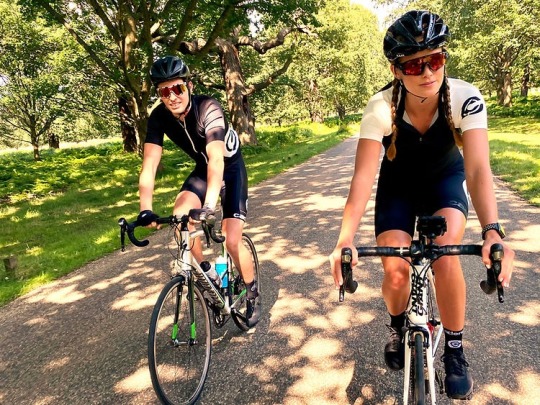
Cadenzia launches in spring 2022 and uses a blend of bamboo viscose and recycled polyester in its cycling jersey.
“Bamboo is woven with recycled polyester to create a super soft, high-performance ripstop fabric that is durable and long-lasting,” explains co-founder Rob Stross.
“Bamboo is a sustainable fiber, has natural performance benefits and is also one of the fastest growing plants on earth and one of the most sustainable and renewable resources on earth. world."
“All of our polyester and nylon fabrics are recycled and Oeko-Tex certified, and we only use YKK Natulon recycled ocean plastic zippers.”
The brand will have a line of cycling essentials, with three out-of-season and gender-neutral colors in its range, aiming to eliminate waste.
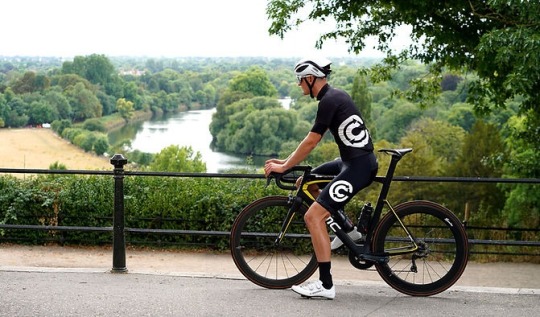
“Our jersey fabric is made in one color, natural unbleached white and the other colors are then computer printed with eco-friendly dyes directly onto the pattern pieces,” Stross adds. ”.
Currently, products verified to contain at least 20% recycled materials can be classified as recycled, and all of its waterproof products are free of PFCs (perfluorinated chemicals used to make fabric is waterproof and very harmful to the environment).
Cadenzia products are manufactured in China and shipped to the UK. When the company established its supply chain in Shanghai, it ensured that it was fully localized to the local area so it could track and reduce its carbon footprint,
2. Endura
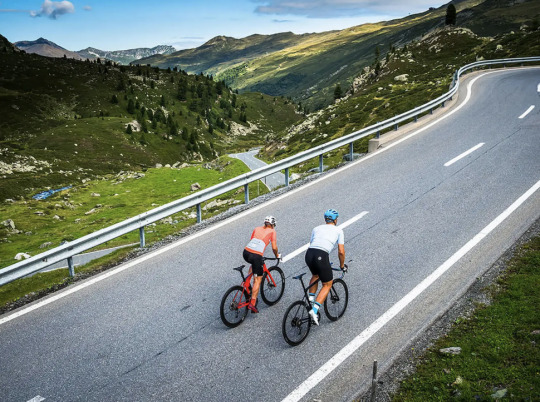
Endura kit is built to last and be durable, which is why Scottish brand Endura, famous for its durable cycle clothing, was born.
Endura incorporates recycled fabrics into its product line in an effort to eliminate waste.
“They chose to use recycled fibers on polyester rather than nylon because they have more impact on polyester and solve the problem of plastic bottle waste,” explains Pamela Barclay, product manager at Endura.
“This reflects why we don't have more styles with recycled fibers.”

According to the brand, 100% of mountain bike jerseys use recycled fabric compared to 33% of road jerseys. However, the brand hopes to increase this final figure to 100% from 2023.
The brand also only markets a product as recycled if it uses more than 50% recycled fibers.
In 2020, Endura launched the One Million Trees initiative, in which they pledged to plant one million trees every year for the next 10 years to offset their carbon emissions and aim to become carbon negative by the year 2024.
Planting began in Mozambique and has now also begun in Scotland, the brand's country of origin. All Endura products have been PFC-free since 2018, and the company makes all its personalized clothing at its factory in Scotland and the rest in China and Asia.
3. Isadore

The brainchild of ex-pros and brothers Martin and Peter Velits, Isadore releases a sustainability report every year, with details of where its products are produced, progress it has made, as well as new aims and initiatives.
The brand is working on core garment traceability and aims to replace all virgin synthetic materials in its products with their recycled counterparts by 2025.
Much of Isadore’s kit is made from recycled materials and the brand recently introduced a majority recycled indoor line.
‘The most important part is that there is no performance difference between using virgin synthetics or recycled fabrics,’ explains Martin. ‘Our Alternative line is made entirely from recycled fabrics and we hope to eventually use 90% recycled sources for the synthetic materials.’
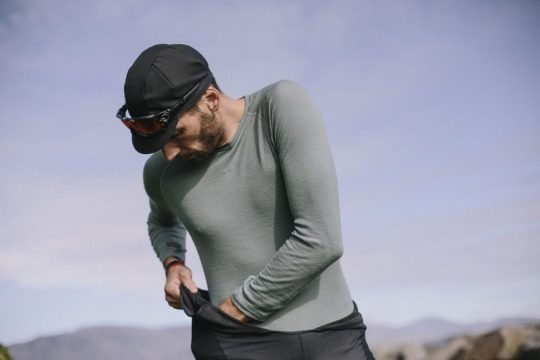
Isadore also uses a lot of merino wool in its products. The wool comes from New Zealand and Australia and then gets processed in Germany where the yarns are produced. The fabric is then woven or laminated in the Czech Republic.
Isadore only works with Oeko-Tex and Bluesign certified suppliers and manufacturers.
Isadore currently doesn’t have the resources to measure and communicate its carbon emissions but is working with its shipping partners to switch to carbon neutral or zero emissions programmes.
The brand plans to have an independent audit to go through all its processes in the future.
4. KOSTÜME

KOSTÜME is a very small new brand which has a different business model to others in this guide. Founded by Ed Bartlett, KOSTÜME caps each of its collections to a small number and pre-sells them in advance which it says significantly reduces waste.
‘The fact is that the fashion industry – and that includes cycling apparel – is locked into a business model that creates unfathomable amounts of waste, right throughout the production and retail process,’ explains Bartlett.
‘We are nowhere near a point where so-called sustainable fabrics are going to fix our ecological problems, so the only way to really make an impact is to stop the waste at source, which is where our model comes in.
‘We also do other things like sharing fabric offcuts across multiple products, no hang tags in our packaging, 100% compostable packaging, working with factories with a clear focus on sustainability – but really it’s the limited pre-order model that makes the difference.’

100% of the current range is made from certified recycled materials, and also feature either bluesign, OEKO-TEX or GRS certification.
The brand’s main factory is 70% powered by renewable energy, and KOSTÜME donates a percentage of every sale to Stripe Climate, an organisation which is specifically focused on investing in carbon capture and removal solutions.
KOSTÜME does not yet track its overall carbon footprint but it has plans to do this in the future, alongside a product repair and takeback scheme.
5. Maap

Australian brand Maap was the first cycling brand to join Bluesign as a full partner.
‘If something is a Bluesign partner, you know that audits have been done and that there will be a certain level of sustainability, which automatically gives you that peace of mind,’ explains Darren Tabone, VP of product at Maap.
‘In our case, Bluesign act like a bit of a big brother, they evaluate your organisation, help review your supply chain and look at all different tiers of the code. Becoming more sustainable is a journey and there’s no real end goal in the sense that you are constantly evolving and learning.’
The brand current uses 95% Bluesign or Oeko-Tex materials and aims to up this to 100% by the end of 2022.

The majority of Maap’s printed fabrics use Green Soul technology which combines sustainable recycled fibres with the environmentally friendly dyeing and finishing processes. It also has had an OffCuts program since 2021 where it makes cycling jerseys out of excess fabric from previous production runs.
The bulk of Maap products are made in Europe and it is expanding its Asia source base.
The brand is not tracking the carbon emissions yet but this is part of its future plan. It is currently in the process of working out the tonnage of products which are from Bluesign-approved raw materials.
6. Matchy Cycling

Founded in 2016, Matchy Cycling is a French brand based in Annecy. All of its products are made from 30% to 100% recycled materials and the brand is extremely conscious of ensuring local production.
‘We prefer a product made in France using a French fabric that is not recycled than a recycled fabrics made super-far away,’ says Geoffrey Baudoin co-founder of Matchy.
‘All of our bib shorts are made in Italy because the chamois come from Italy so it avoids unnecessary shipping.
‘Some fabrics made by a supplier in France are three times more expensive than usual fabrics but offer a much better durability. It’s a complex topic and we need to look outside of just recycled fabrics even if it’s still an important point for us.
‘All recycled fabrics are not equal, it depends on the supplier and where they come from. The trend has obliged suppliers to invest in these fabrics and we can now say that recycled fibres are almost equal as virgin fibres.’

This year, Matchy begun tracking its footprint and is working with third parties to help understand it. The brand also hopes to become a B Corp by the end of this year.
‘Offering recycled products is one thing but we really try to go deeper as globally we need to reduce our impact which means extending the life cycle of the products, by repairing them, or giving them a second life,’ adds Baudoin. ‘We are working with a local tailor to offer upcycled products this winter.’
All of Matchy’s products are Bluesign-approved and use OekeTex material. The brand does not use any plastic packaging, only recyclable and compostable materials.
7. Rapha
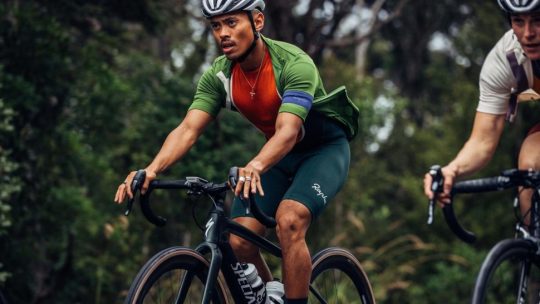
Rapha currently produces 90% virgin materials and 10% environmentally preferred materials (recycled, certified organic or animal welfare versions) by volume but has pledged to flip this on its head by 2025.
‘Some people might be not impressed with 10% today, but it’s all about what we’re trying to get to,’ explains Duncan Money, Rapha’s head of social and environmental impact. ‘It is a journey, and we will be doubling that figure nearly every year to get there.’
Like Endura, Rapha doesn’t publicly market a product as environmentally preferred until this accounts for more than 50% of the product by weight.

Rapha aims to become carbon neutral by 2025, across scope 1, 2 and 3 emissions.
- Scope 1 emissions refer to direct GHG emissions that occur from sources that are controlled or owned by an organisation, such as emissions from company vehicles
- Scope 2 emissions refer to indirect GHG emissions associated with the purchase of electricity, steam, heat, or cooling, and are a result of an organisation’s energy usage
- There are also Scope 3 emissions, which include all other indirect emissions that occur in a company’s value chain
It is currently working on its Science-Based Targets and will release these in the middle of the year.
Rapha is also one of the founding signatories of the Shift Cycling Culture Climate Commitment.
‘Even if you just looked at it by weight, it’s quite obvious which one we should be addressing first and which one people should be challenging us on,’ says Money.
‘The cycling industry has the potential to be an incredible force for good in the world, but to make the necessary changes we need to take action with urgency, together.’
Rapha is a member of the Sustainable Apparel Coalition and uses Bluesign and Oeko-Tex certified materials
8. TIC CC

In 2019, TIC CC undertook a year-long period of ‘environmental reflection’ which led to 95% of the brand’s SS21 collection being made with recycled fabrics.
The brand also reworked its supply chains so that 98% of fabrics and components now come from Europe.
For TIC CC co-founder Andrew Monk, taking a holistic approach is an important factor to an evolving sustainability journey.
‘We find that a combination of recycled and virgin fabrics works best,’ says Monk.
‘Of course, this will change as technology improves but you have to take a holistic approach, looking at other impacts including production methodology and distance travelled from source.’
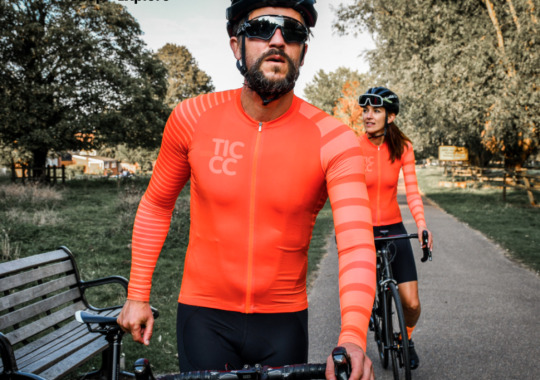
Notably, TIC CC advocates using a Guppyfriend washing bag when washing cycling clothing.
Washing cycling kit in this bag prevents microplastic pollution from synthetic micro fibres getting into waterways.
TIC CC and all of its key manufacturing partners use 100% renewable energy and the brand uses Bluesign and Oeko-Tex certified materials.
TIC CC kit is made in Europe, and its caps are handmade in the UK.
The brand has been tracking its emissions internally for the past three years and is considering getting this data accredited in the futu
9. Universal Colours

London-based Universal Colours takes an innovative conscious approach to its products.
The brand uses pre-consumer waste and post-consumer waste fabrics and a fluorocarbon-free durable water repellent (DWR), called C0 which is a sustainable, vegetable-based technology.
The brand aims to produce considerately sourced cycling clothing but to also educate the consumer on how to care for its garments in order to maximise their longevity.
‘With all our waterproof jackets we give a sample of Nickwax aftercare to reproof it,’ says Will Hurd, a designer at Universal Colours. ‘It’s really important that we communicate to our customers the importance of looking after a product. It’s wrong to assume that customers know what reproofing is.’
But it isn’t straightforward as Hurd explains: ‘We have our own paradox and our own complications because we know our price points are not accessible for everyone. But I think we are very clear and transparent about our fabrics, our costs and have strong ethical policies that we stand by.’
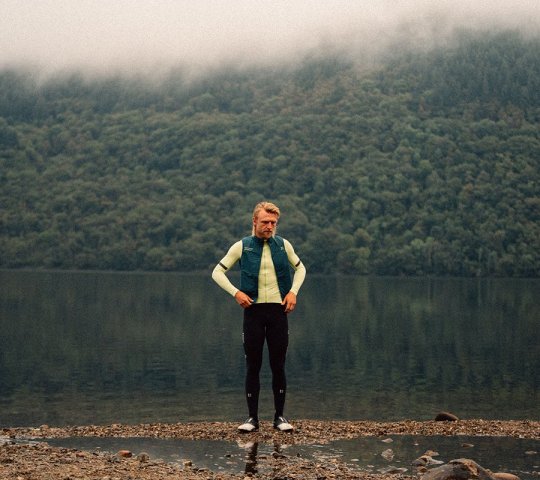
The brand also champions a circular approach, notably in its 100% taste-free biodegradable polyethylene bottle constructed using sugarcane, which can be wholly recycled.
At the correct temperature in a landfill or under leaves and soil in a forest, the bio-batch additive activates, and the bottle decomposes into water, humus and gas.
The brand says the composting process takes 1-5 years, compared to 450 years for a traditional plastic bottle, and the bottle becomes part of the natural world again.
Most of its products are produced at LTP in Lithuania which is a Bluesign-accredited factory, and the brand also works with a factories in China and Taiwan for select products.
Universal Colours is currently looking into tracking its emissions and is also a member of 1% for the planet
10. Velocio

The majority of Velocio’s products incorporate recycled or natural fibre, including all of its Spring/Summer jersey line. The brand is aiming to expand the use of these materials into the rest of its collection.
Velocio makes its kit in facilities which use renewable energy, primarily solar and produces clothing in small-batch quantities in order to conserve energy, limit overstock and reduce liquidation.
‘It’s ironic given that the bicycle can be such an environmentally friendly mode of transportation, but the industry at large, especially at the aspirational end, has pushed newer/better/faster as their primary marketing language for so long that bikes are essentially disposable,’ says Brad Sheehan, CEO and co-founder of Velocio.

‘That mentality has been absorbed by consumers and it’s the main thing we hope to push back on.’
‘It’s also not enough to just use recycled fabrics. We’re also looking at the manufacturing partners, fabric suppliers, and end of life phases of our apparel to see how we can improve the entire life cycle.’
Velocio uses Bluesign and Oeko-Tex certified suppliers and is also a member of 1% for the planet.
Interested in sustainability and cycling? Check out
Read the full article
0 notes